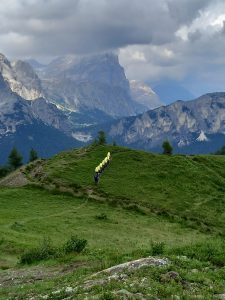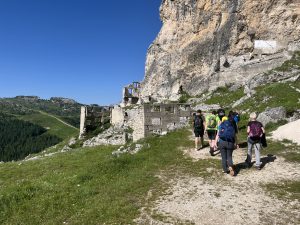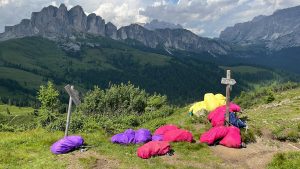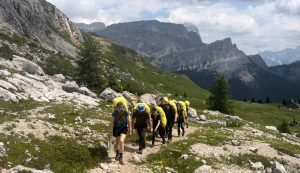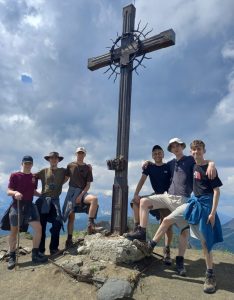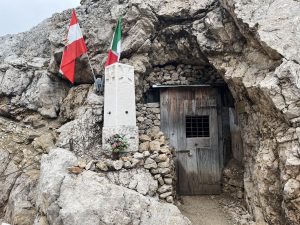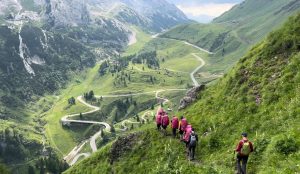During the period 14-23 July 2024 a team of 21 cadets and 8 staff from Derbyshire Sector in Trent Wing headed out to the Dolomites Region of Italy. After a year of planning and UK based training, the team assembled at Manchester Airport to fly out to Venice Marco Polo Airport and then collected their hire vehicles and took the 2hr drive to Marmolada Campsite where they were to be based for the next week – meeting up with the advance party of Flt Lt Hill and Flt Lt Beal who had driven out ahead with much of the group kit needed to save on baggage costs.
Straight away the team were amazed with the vastness but rugged beauty of the region, with views from the campsite to the Marmolada Glacier and surrounding peaks that would be the route for the expedition phase. An acclimatization day allowed the team to pack and shop for the expedition, whilst allowing their bodies to adapt to the change of altitude (now at 1600m) before the push to nearly 2500m on the expedition. Shopping in particular was a challenge with the supermarket being more of a Tesco’s Extra so compromises had to be made on the planned menus, with the additional challenge of converting costs from euros to pounds to ensure they stayed within budget.
The main thrust of the expedition was linking a number of significant sites from WW1 conflict between Austria and Italy into a 4 day hike the cadets would use as the qualifying expedition for their Gold Duke of Edinburgh’s Award, with the cadets being divided into 3 teams.
Day 1 saw a 1hr drive to the start point beside the Forte de Fitra Sas Museum and involved the team initially walking around the Lago Valporola and under the towering cliffs of Ete Pale de Gerua to reach the Bivuoac at the col beneath Pico Setsas. The paths were well marked with finger boards with path numbers, and red and white paint on rocks at intervals but straight away the path presented challenges with some scrambles and walking across rockfall, probably that happened in winter. From there the team followed the Seleghe ridge line before forking left to avoid going onto the col to the east of Col di Lana where it was possible to take a short but steep scramble to the summit. The summit was marked by memorials, a church and a rifiguio along with the most amazing views, before descending a steep winding path into forest to reach the finish point of Livinallongo – although only 14km the route had 1000m of ascent and proved a significant challenge.
Day 2 saw the teams take a steady climb, first through forest and then open alpine meadow of Val de Davedin to reach the pass at El Jof (2200m). This took the team past the remains of numerous outposts to track the movements of the Austrian troops and at the pass there was further evidence of armaments along with the first views across to the Marmolada Glacier containing the infamous Ice Fortress the team were due to visit at the end of the expedition. The teams then took a scenic descent to the main road before again climbing to reach then handrail the southern edge of the picturesque Lago Fedaia (of James Bond car chase fame) to the wild camp at the base of the north dam.
Day 3 started with a steady climb on the alpine meadow north of Lago Fedaia to the Gondola Station near the summit of Padon on a mostly overgrown path where the teams were met with an artillery gun. Having passed some well-hidden WW1 view posts teams took a break to admire the view before taking a picturesque ridge walk past the peak of Crepe Rosse back to El Jof pass. From here the teams again descended to the road but turned south to follow the cable cars under the towering face of Sas de Roi back to Marmolada campsite.
Day 4 was an early start but much less demanding route through the gorges of the Pettorina River to meet the Sottoguna River and follow to Alleghe but unfortunately the best sections were closed with a scramble through forest beside due to ongoing repairs and new bridges being built follow damage from the 2019 tornado (work delayed due the Covid pandemic). That said the route was very pleasant and a relief after 3 hard days of mountain walking. The early start was to leave time in the day to get back to the Marmolada Glacier Gondola to go and visit the “Ice Fortress” and museum, but unfortunately the weather had closed in and the top was shrouded in cloud, so the decision was taken to leave it until the following morning.
On the Saturday morning the team got the first gondola up and went for the viewpoint on the top of Monte Rosse (3250m) and were lucky to get views through broken cloud of the surrounding peaks before descending to the museum the team were able to explore the museum at length and also walk out onto the rock outcrops that had the quarters, ammo stores, view posts and artillery positions. It was chilly in the middle of summer so who knows what it must have been like for soldiers dressed in their WW1 uniforms – the museum said that many died from exposure to the conditions rather than enemy fire, but the site was considered a strategic stronghold to be held at any cost.
Sunday was via Fatta day and at the guides’ suggestion the team got up at the unearthly hour of 6am to head up to Passo Fortzala and meet at 0730 to get ahead of the crowds which was just as well, as being a nice day, it got very busy. Following kit issue and briefing the team walked the 30mins in to the start point of the Feratta Alpina, one of the original via feratta routes put in but Italian Army Mountain Tropps to flank the Austrian forces, and although now replaced with new wires and pitons evidence of the original routes could still be seen, several Italian lives were lost putting these routes in by hand in freezing conditions. The start of the climbing route was marked by the ruins of a WW1 field hospital, with lots of information boards which when we later translated said they are looking to rebuild bits for the “history of the conflict to be known”.
The via feratta itself was classed as ‘moderate’ and took between 3-4 hours normally and was a mix of climbing on rock and using metal steps hammered into the rock protected by being linked to a metal wire through the harness (hence the translation of “way of iron”) and the guides having the teams tied by rope for extra security, The route was fun, “squeaky” in places, some great but safe exposure and amazing views throughout. The route back was a knee jarring descent down a zig-zagging path ensure all the team earned their waiting pasta dish at the Rifugio back at the start point!
The final day meant relocating to a new campsite near Venice Airport due to the 0700 flight the next morning but did mean the team got an afternoon’s R&R to take in the sights and history of Venice which was a welcome relief after a week of working hard in the mountains.
The trip was only possible due the generous sponsorship of a number of funders especially the Ulysses Trust, RAF Charitable Trust, HQ Trent Wing, Air Cadet Charity, The Masons and East Midlands RFCA without whom the cadets would not have had the experience of a lifetime and are now fully motivated to complete the other sections of their Gold DofE Award as soon as possible.
Quotes
“When I joined cadets I never dreamed of an opportunity like this, at times I really thought I couldn’t do it but team and staff support kept me going and the amazing views will always stay with me.”
Cpl B 1890 Sqn
“I’ve been doing DofE a long time but to give the cadets an opportunity like this is amazing and I hope they use it to get an opportunity to talk to whoever is their principle guest at their Gold Award Presentation when they get there.”
WO L 331 Sqn
The Ulysses Trust also wish to thank the generosity of the Royal Air Force Charitable Trust for supporting this expedition. www.rafct.com



